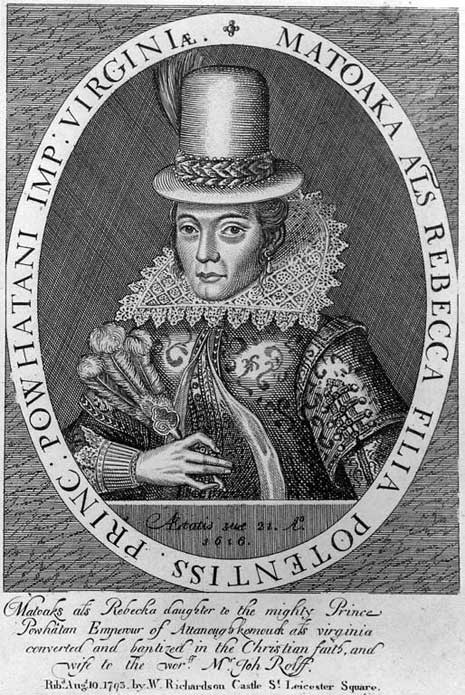The Legends of Pocahontas
This post first appeared on December 10, 2018
Fact is difficult to distinguish from fiction in the case of Pocahontas. The colorful stories often associated with her—bringing food to starving English settlers, falling in love with John Smith, and rescuing him from death at her father’s hands—were all written after her death, when she could no longer confirm or contradict them. The Englishmen who originated these tales had commercial and personal reasons for burnishing Pocahontas’s legend. Whether drumming up support for colonial enterprises in North America or embellishing their personal reputations, many found it advantageous to make Pocahontas the poster child for peaceful coexistence between white settlers and Native Americans.

A poster of sorts was in fact created during Pocahontas’s visit to England as the guest of the Virginia Company in 1616. The Flemish artist Simon de Passe made an engraving of the visiting American, which was widely reproduced. It is apparently the only portrait made of Pocahontas during her lifetime, and it clearly reveals her makeover by the English. Six years earlier, an eyewitness described Pocahontas as a “well featured, but wanton yong girle,” accustomed to arriving naked at the English fort in Jamestown to turn cartwheels with the young boys. In de Passe’s engraving, by contrast, she is entirely encumbered by clothing— her head dwarfed by a tall hat, her neck hidden by a stiff lace collar, and her body encased in layers of ornately patterned fabric. Latin and English inscriptions describe her relationship to Powhattan (chief of the Algonquian-speaking tribes of the Chesapeake) in terms of European nobility, identifying her as “daughter to the mighty Prince Powhatan Emperour of… Virginia.” The print also advertises her conversion to Christianity and her marriage to an English colonist, describing her as “converted and baptized in the Christian faith, and wife to the worthy Mr. John Rolff.”
De Passe’s engraving provided the model for a later painting in which an unidentified artist softened Pocahontas’s features and simplified her costume, but otherwise adhered closely to the original. Inscriptions once again note her conversion to Christianity, her “royal” birth, and her marriage to an English colonist, misidentified as Thomas Rolff (her son, rather than her husband). Over the succeeding centuries, only the notion of Pocahontas’s royal stature has endured as a key feature of her identity. Other attributes have embellished the bare facts of her brief life and transformed her into a national myth. It is an open question whether Pocahontas herself would recognize the legendary figure that 500 years of creative storytelling has engrained in the American imagination.